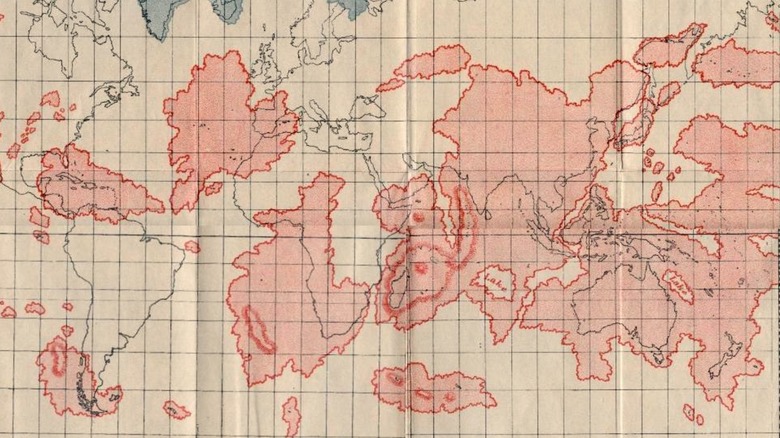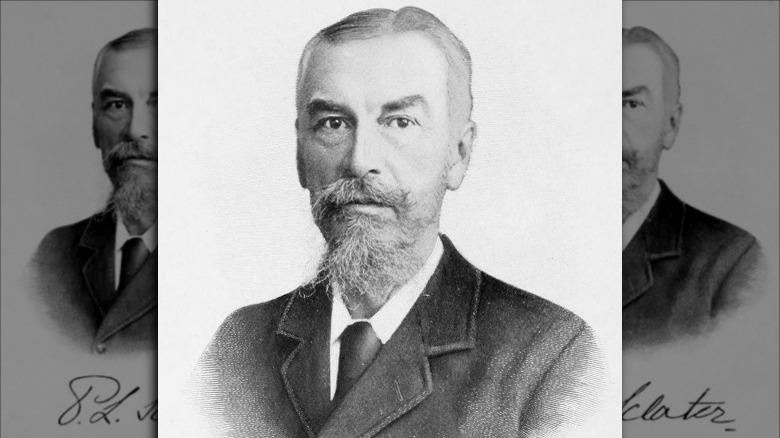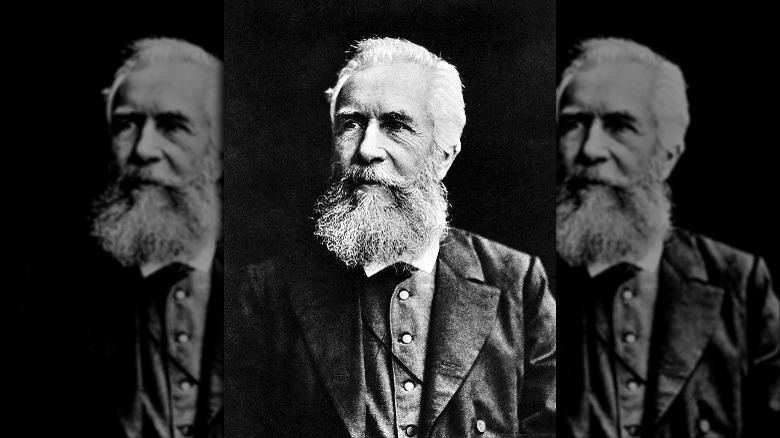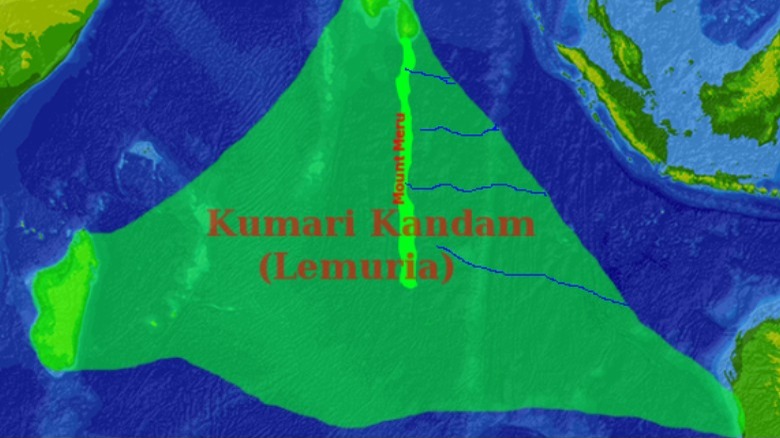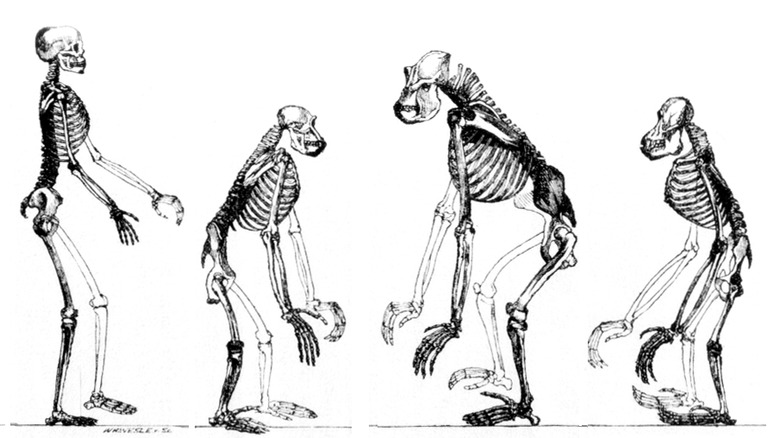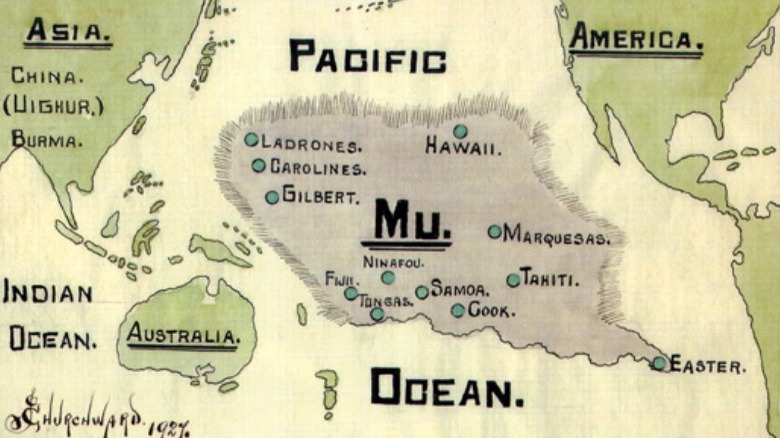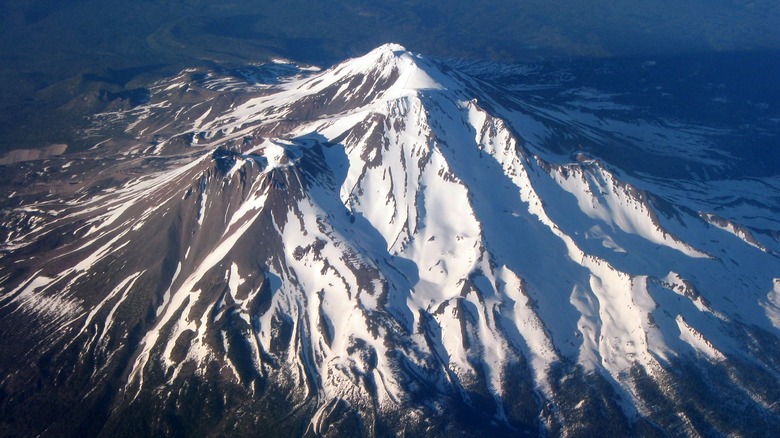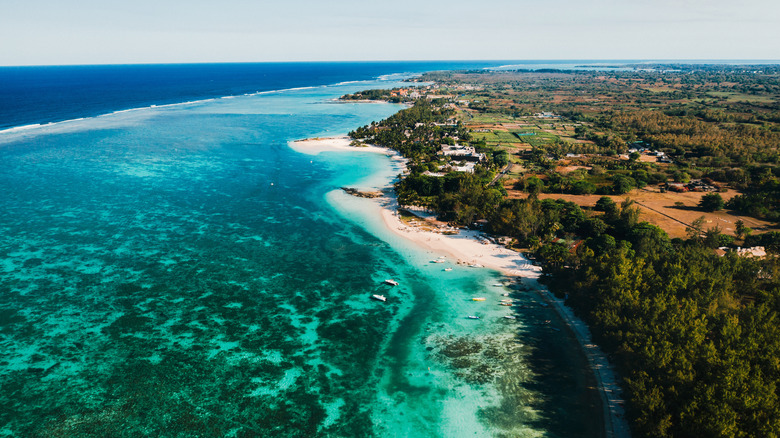The Untold Truth Of Lemuria, The Atlantis Of The Pacific
While Atlantis is the most famous sunken continent, it's not the only one that's ever been postulated by writers, thinkers, scientists, and mystics. After all, why should the Atlantic Ocean have all the lost-continent fun? After Atlantis, the sunken continent that is probably most widely known is Lemuria, variously located in either the Indian Ocean, the Pacific Ocean, or both.
Unlike Atlantis, which began in ancient times as a legend and thought experiment, Lemuria began in modern times as a hypothesis by a highly respected scientist. Then, others latched on to the idea and it was wildly expanded by occultists and nationalists in southern India. It's a pretty wild ride from "where did these similar bones in distant places come from" to "volcano full of monster people in northern California," so hang on to your hat and let's dive down to the murky depths of the lost continent of Lemuria.
The scientific origins of Lemuria
While Lemuria has become a concept heavily entrenched in secret societies, mysticism, and the occult, it didn't start out that way. Lemuria was originally conceived as a legitimate scientific hypothesis put out there by a real scientist. It's also a much more modern idea than Atlantis, which has its roots in legends of Ancient Greece. As Gizmodo explains, Lemuria was hypothesized in the 1850s by Philip Lutely Sclater, a highly respected ornithologist who collected thousands of specimens for the British Museum. When Sclater was in his 20s, he began a study of the fauna of Madagascar, and he soon noticed that the fossils of animals he found there were similar not only to those on mainland Africa, but also to those in India.
The now commonly accepted geological theories of continental drift and plate tectonics were still about a century out from being a mainstream idea, so Sclater drew his own conclusions about how animals could have lived in both Madagascar and India without land between them. He theorized that there used to be land between them. Land bridges were a common explanation at the time for things now explained by continental drift, and there are sunken continents in the Indian Ocean, so Sclater's idea that there used to be a continent bridging eastern Africa and India wasn't completely out of left field.
The lemur connection
If you're not already familiar with the idea of Lemuria, chances are good that the first thing that will strike you about it is that it has the word "lemur" in its name. You might dismiss this as a coincidence. Maybe "lemur" means something that you just don't know? Maybe it's just a soundalike word? Well, good news: Lemuria is definitely called that because of the animals.
All That's Interesting explains that Madagascar was the center of Philip Sclater's research at the time when he hypothesized Lemuria, so naturally lemurs were prominent in his work. Sclater noticed that while mainland Africa and India both had species of lemur, Madagascar had a much wider variety. This led him to the theory that Madagascar was the origin point of the big-eyed primates and that they had traveled along his theoretical land bridge that spanned from southern India to southern Africa to western Australia in a big triangle. Since he was primarily concerned with the movements of lemurs, why wouldn't he call his lost continent Lemuria?
The word lemur has its origins in the Latin word lemurēs, meaning "spirits of the dead." The animal was given its name by biologist Carl Linnaeus because of their spooky appearance and nocturnal movement. Lemuria was also the name of an ancient Roman festival of the evil dead, where people would try to appease ghosts by throwing beans at them.
Was Lemuria the Garden of Eden?
So far, there's nothing too weird about Lemuria. It's a fairly reasonable hypothesis by a legitimate scientist to explain a weird discontinuity in the fossil record using the best understanding that modern science had to offer at the time. Scientific American reports that Philip Sclater's Lemuria was not the only hypothesized lost land bridge at the time, nor was it the first proposed land bridge between India and Madagascar. As such, it's not unlikely that the idea of Lemuria would have simply faded away as many of these other hypothetical land masses had were it not for some zealous writers. Key to the expansion of the idea of Lemuria was the German biologist Ernst Haeckel, who included ideas about Lemuria as part of his 1868 work "The History of Creation."
Haeckel believed that Lemuria wasn't just the origin of the development of lemurs, but also of humans. At the time, humankind was believed to have arisen in Asia, but the idea of humanity originating in Africa was gaining traction. Haeckel thought that an area connecting the two might be the true solution. Later editions of Haeckel's book really drive home the connection between Lemuria and the birth of the human race by labeling the lost continent as "Paradise," explicitly identifying it with the Garden of Eden.
The Tamil legend of Kumari Kandam
However, Ernst Haeckel was not the first person to theorize that a lost continent now sunk beneath the waves of the Indian Ocean was the true cradle of humanity. According to Ancient Origins, the Tamil — a people indigenous to south India — have a story of a lost continent that dates back to ancient times, with the name Kumari Kandam being applied to this sunken land in the 15th century. The stories tell of an early Tamil dynasty known as the Pandiyan kings, who ruled over Kumari Kandam before it was swallowed by the sea.
When the concept of Lemuria was introduced into colonial India at the end of the 19th century, it hit at a time when two key things were happening. A Tamil cultural renaissance was occurring, which led to both the infusion of Tamil folklore into the accepted understanding of history and a rise in Tamil nationalism. The idea of Lemuria came at just the right time for it to flourish. By the early 20th century, Lemuria was being identified with the 15th century story of Kumari Kandam. The land was touted as the birthplace of all humankind and the home of the Pandiyan, who had been rulers of the entire Indian subcontinent. Presenting the Tamil people as the oldest civilization in the world and its language as the world's first was key to nationalistic sentiments of the time.
Madam Blavatsky gets weird with it
It was the now-expanding conception of Lemuria as the birthplace of the human race that brought it to the attention of occult circles. By the 1880s, the idea of Lemuria was appealing to Helena Blavatsky, the co-founder of the Theosophical Society, a mystical occult organization founded in 1875 in New York.
Encyclopedia.com explains that Madam Blavatsky incorporated ideas of Lemuria into her cosmological history of the human race, while adding several rather unique ideas of her own. According to Blavatsky, humanity had evolved — and was still evolving — through a series of seven stages. Blavatsky claimed that the current human race was the fifth race, while the Lemurians had been the third stage in humanity's development.
Later Theosophists picked up on Blavatsky's ideas and further expanded the concept of Lemuria. Perhaps the most notable theosophical writing on the subject was the 1904 work "The Lost Lemuria" by William Scott-Elliot, which included a map showing that the current conception of Lemuria was far more than the simple land bridge that Sclater had proposed. Scott-Elliot's Lemuria was a vast continent stretching from India to New Zealand, of which Australia was a surviving piece. He also posited that Aboriginal Australians were descendants of ancient Lemurians. Theosophist Charles Webster Leadbeater, who claimed to have gained knowledge of Lemuria through "astral clairvoyance," describes the Lemurians as egg-headed creatures walking lizards on leashes.
Lemuria and the evolution of humankind
Central to the concept of Helena Blavatsky's evolution of the human race are what she called the seven root races, which are the different stages of human development across time. According to Blavatsky, humanity now stands at the fifth stage, of which the root race is the Aryans. Yes, this is some nonsense that the Nazis ate up like delicious pudding.
Theosophy World explains that, under this belief system, the first race was the Polarians, ethereal, non-corporeal beings who reproduced asexually like amoebas. The second race was the Hyperboreans, who lived at the North Pole — which was tropical at the time — and reproduced via balls of sweat. The Lemurians were the third race, and they were 15-foot-tall, four-armed, hermaphroditic beings that laid eggs and coexisted with dinosaurs. Originally they had only one eye, but they then developed three eyes, and then eventually the third eye turned into the pineal gland. Also, they eventually invented sex about 16.5 million years ago.
The fourth race was the Atlanteans, of whom you may have heard. The Theosophists believe that the Atlanteans were the first humans to develop speech, and that their language was the basis for Sanskrit. They were also evil wizards, which is why they had to be destroyed by a flood. The fifth race was of course white people, and the sixth race will be androgynous ghosts who live in Baja California. Nothing is known about the seventh, final stage of human development.
The lost continent of Pan (and later Mu)
The original conception of Lemuria was clearly in the Indian Ocean, spanning from Madagascar to the southern tip of the Indian subcontinent, but as time went on and the idea was conflated with other lost mystical lands, the physical area of Lemuria expanded until it covered a good chunk of the Pacific Ocean as well. One other such sunken continent that was soon identified with Lemuria was the lost continent of Pan, which is described in the 1882 Spiritualist text "Oahspe: A New Bible," by John B. Newbrough.
Encyclopedia.com explains that Pan was a large continent that covered the north Pacific, and its remnants included the land that is now the western coast of California. California, like Madagascar, has its own hard-to-explain flora and fauna, and so the idea of California as a surviving chunk of a lost land only increases in popularity after Newbrough.
Newbrough, by the way, was a dentist. Got Questions explains that he wrote "Oahspe" through the spiritualist technique of automatic writing, in which the medium enters a trance and lets an external force — in this case "the angel hosts of heaven [...] in the name of Jehovih" — control their body to do the writing. "Oahspe" inspired a small spiritualist movement called the Faithists, which encouraged pacifism, vegetarianism, and the belief in an ancient sunken continent whose symbols were the basis for many of their rituals.
Getting the Mayans involved
Encyclopedia.com explains that New Age beliefs regarding Lemuria were also popularized by the work of an amateur archeologist named Augustus Le Plongeon. In the late 19th century, Le Plongeon had been studying Mayan hieroglyphics at Chichen Itza and claimed to be able to read them. He stated that the glyphs told the story of a princess of a lost continent, which he presented in a book with the inarguably scientific-sounding title, "Queen Moo and the Egyptian Sphinx." This text claimed that Princess Moo had fled the Yucatan for an ancient continent called Mu, which Le Plongeon identified with Atlantis. Perhaps needless to say, Le Plongeon's ideas were pretty roundly ignored by the legitimate archeological community.
They were not, however, ignored by the occult writer James Churchward (above), who picked up on Le Plongeon's ideas in his own work. Churchward claimed to have found and deciphered a set of tablets in the lost (fictional) Naacal language, which told the story of the sunken continent of Mu, which Churchward moved from the Atlantic to the Pacific Ocean. He presented his ideas in his 1926 book "The Lost Continent of Mu," which described Mu as an enormous continent in the Pacific, south of Hawaii. Needless to say, moving Mu to this location led to its being conflated with that other eastern hemisphere sunken continent, Lemuria.
Spoilers: California has been Lemuria this whole time
As a result of ideas about Lemuria, Pan, and Mu getting combined into one sort of uber-continent that spanned two oceans, the conception of Lemuria continued to evolve. Encyclopedia.com says that the author and mystic H. Spencer Lewis, under the pseudonym Wisar S. Cerve and building on the 1894 book "A Dweller on Two Planets," moved Lemuria entirely into the Pacific Ocean.
He also said that when the continent was destroyed, its remnants slammed against the western edge of North America, becoming California and forming the north Californian volcano known as Mount Shasta. Since then, California in general, and Mount Shasta in specific have become central to modern beliefs about Lemuria, with the general idea being that the surviving Lemurians live inside the volcano, which is hollow.
A number of secret, mystic, and theosophical societies subscribe to the belief that Mount Shasta is full of lemur people, including the Rosicrucians (of which Lewis was part), the Great White Brotherhood, the Church Universal and Triumphant, and, perhaps most notably, the Lemurian Fellowship, which formed in Chicago five years after the publishing of Lewis's book. The Lemurian Fellowship teaches that the continents of Atlantis and Mu did literally exist and sink beneath the waves, one in the Atlantic Ocean and one in the Pacific. Don't worry, though: they also claim that Lemurian philosophy and cosmology is still compatible with Christian beliefs. Whew.
The most famous Lemurian of all
In the height of the 1980s New Age movement, an individual Lemurian became something of a celebrity in those circles. His name was Ramtha, and he was the spirit guide of a writer from Washington state named J. Z. Knight. Encyclopedia.com explains that Knight claims Ramtha first appeared in her home one afternoon in 1977. He would subsequently possess her body to move and speak through her, Knight claimed. Under these circumstances, Ramtha became the focus of a fairly sizable New Age cult known as Ramtha's School of Enlightenment.
According to Ramtha, he lived on Earth 35,000 years ago in Lemuria, which was not a separate continent of its own, but rather a subsection of an ancient continent called Atlatia, which is understood to be Atlantis. During Ramtha's lifetime, the northern portion of Atlatia, including Lemuria, was destroyed due to negligent use of technology, which forced Ramtha to move to the south, where he became a mighty warrior and conqueror. After conquering three-quarters of the world, Ramtha left the conquering life after a near assassination and spent the next several years in search of God.
He mastered mystic abilities including out-of-body experiences and ascended from this earthly plane. He returned in the '70s to tell people that they too can be Atlantean space ghosts if they learn to transcend the limitations of the physical form.
Lost Lemuria found?
Lemuria's unusual origins haven't stopped some people from wondering whether there's some truth to a sunken continent in the Indian or Pacific Oceans. All That's Interesting reports that in 2013, geologists found granite fragments (a common rock in continental crusts) in the Indian Ocean on a shelf near Mauritius. Additionally, on Mauritius itself, scientists found zircon that predated the formation of the island by billions of years, leading some to speculate that the zircon had come from an older landmass that had sunk to the ocean floor before later being shoved back up to the surface by plate tectonics. While this evidence would seem to vindicate Philip Sclater to some extent, the name applied to this landmass was Mauritia, not Lemuria, and it definitely would have sunk before lemurs evolved.
Scientific American isn't buying any of it, writing that excited journalists misunderstand how and where granite is formed, and that it's actually impossible for a continent to just sink due to the relative densities of continental crust and the mantle materials below.
Lemuria in story and song
Lemuria is a mysterious lost continent with some smidgeon of scientific credibility behind it that was then greatly amplified by its connection to mystical societies and conspiracy theories, so it's not really surprising that it's been a common topic for creators of pop culture. While it lags far behind its Atlantean cousin in terms of references, Lemuria pops up in the H. P. Lovecraft story "The Haunter of the Dark," where it is mentioned as a former location of the cursed item known as the Shining Trapezohedron. Lovecraft's friend and contemporary Robert E. Howard included Lemuria in his stories of both Kull the Conqueror and Conan the Barbarian, where it is an island nation full of barbarian pirates that is destroyed in the Great Cataclysm.
There are two different versions of Lemuria in the Marvel Comics universe, one which is the underwater rival of Atlantis, and one which is the underground home to a group of the ancient race known as the Deviants, the enemies of the Eternals. With Academy Award-winning director Chloe Zhao's "Eternals" set to hit screens in 2021, chances are good an entirely new audience will be exposed to the lost continent.
Perhaps most amusingly, the 1990 Pixies song "Velouria" is all about a guy in love with a Lemurian (her name even rhymes) with shiny fur that lives inside Mount Shasta.
